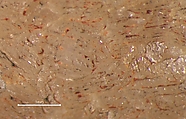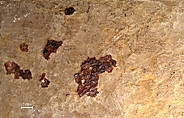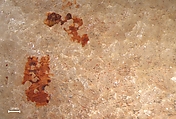On loan to The Met The Met accepts temporary loans of art both for short-term exhibitions and for long-term display in its galleries.
Marble head of a figure
Technical methods of examination: Multiband imaging, optical microscopy, X-ray fluorescence spectroscopy, X-ray diffraction, Raman spectroscopy
The head belongs to a large Cycladic figure comparable in scale to the largest figures currently known. It is broken at the lower neck and has losses to the surface at the center back of the head and lower back of the neck. The surface exhibits a discontinuous dark yellow to red patina on a very coarse-grained (maximum grain size ≈ 1.5 cm) heteroblastic marble characterized by heavily and uniformly dissolved calcite grains. The face is narrow and elongated with angular transitions from the jawline and chin to the top of the head, which has a slight lyre-shape. The long broad nose projects prominently and is placed at the center of the face. There are no visible traces or ghosts of pigment.(1)
Large heads without traces of pigment are among the easiest class of Cycladic artworks to forge and are particularly difficult to authenticate when they have no secure archaeological provenance. They also command large sums on the art market. The dark yellow patina, which is gypsum-rich and has high iron, copper, zinc, and arsenic contents, and the isotropic and uniform weathered surface suggests to us that it has been induced with a chemical treatment. The surface patina is similar to the female figure, L.2022.38.109, and the bowl, L.2022.38.87.
Seán Hemingway, Dorothy Abramitis, Federico Carò
(1) In the Emmerich catalogue (1965), p. 14, it states that faint traces of the right eye are preserved but this was not at all visible to us.
Due to rights restrictions, this image cannot be enlarged, viewed at full screen, or downloaded.
This artwork is meant to be viewed from right to left. Scroll left to view more.














